Gold crowns are no longer relevant. They were replaced by modern implants and prostheses. The choice is quite large, so any person will be confused and ask quite logical question your dentist: which removable dentures are best. If the situation is too advanced and it is impossible to use non-removable devices, then it is necessary to use special dental prostheses: removable dentures.
What are removable dentures?
To date, in dentistry, there are many devices of a removable type that can be selected for any patient, based on his needs. The range is determined by the number of whole teeth. So, if a person has no teeth at all, then a complete prosthesis is made. When in oral cavity there is still something to attach the structure to, clasp devices are used, which today are recognized as the best.
Two complete removable dentures
The only option for prosthetics in the absence of one or both dentitions is complete. Materials for removable dentures complete type- acrylic, nylon. Similar devices for last period were subjected to a number of clinical trials, as a result, their shortcomings were significantly improved. Among these cons were unaesthetic appeal and unreliability.
Created according to innovative systems, artificial devices are characterized by excellent external data and very high strength.
If a person follows all the principles of hygiene and wear, the designs will last long enough. long period and retain their external data, texture and hue. Moreover, products can be created based on the desires of the client and his personal characteristics.
In order for the structures to hold firmly in the mouth and not cause discomfort to a person, such types of removable dentures, as in the photo, should be installed on mini implants for fixing removable dentures. A more expensive option would be to install devices on special suction cups, but dentists do not advise putting them on the bottom row. Innovative systems made from quality materials are almost indistinguishable from real teeth. They adapt very quickly in the oral cavity.
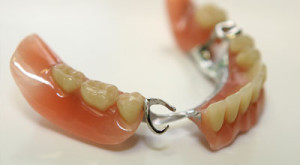
Dental prosthetics on implants
Removable dentures: which types are better: nylon or acrylic?
For a detailed answer, you need to compare the characteristics:
- Lightness and elasticity. Nylon constructions have a special elasticity and softness, however, they are no less durable than acrylic ones. Acrylic fixtures are lighter in weight, but can store the configuration for a long time;
- Purity. Nylon does not produce specific odors, does not absorb moisture, and is an environmentally friendly material. What can not be said about acrylic, on which harmful microorganisms are collected, against which inflammation may occur;
- aesthetic appeal. By their shade and configuration, nylon products are difficult to distinguish from real living teeth. They retain their aesthetic appeal throughout the entire operational period. The disadvantage of nylon products is that artificial teeth are visible through them. With acrylic products, you can choose the appropriate configuration, shape and shade;
- Hypoallergenic. Nylon devices are characterized by excellent biocompatibility. Acrylic structures can provoke allergies;
- Price. Nylon devices are more expensive than acrylic products as they are manufactured overseas. In general, the cost of fixtures is quite affordable.
Answering the question which of the above prostheses is better, it is worth saying that when choosing, dentists must conduct a preliminary analysis of the state of health. Most importantly, look at the condition of the gums and determine the correct number and condition of the teeth. Among other things, the practical and aesthetic side and financial capabilities of the client are taken into account.
Undoubtedly, devices made of zirconium dioxide are considered the most reliable and effective. They are attached directly to the implants. However, many patients are not satisfied price policy and they refuse this procedure.
Partially removable
Systems on special frames made of metal or plastic are designed to fill gaps with lost teeth.
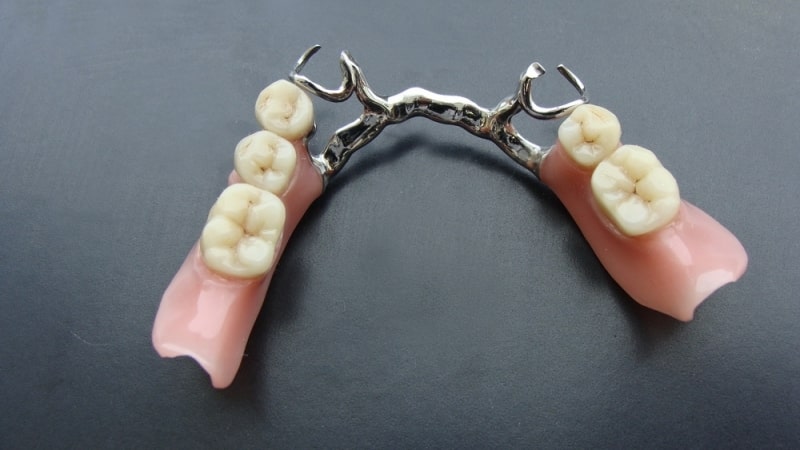
Clasp prosthesis
Plastic products have a democratic cost, but in the process of chewing they do not provide the correct load on the gums. Due to the uncomplicated fastening structures, the client can take out the prostheses with his own hands for hygienic cleaning and install them back.
Dentures are used to replace missing teeth and are recognized as the lightest orthopedic system that is affordable. The structures are able to be effectively fixed in the oral cavity and, with the help of special hooks, hold on to adjacent teeth.
Removable clasp prosthesis is recognized as the most reliable and practical in use. It is characterized by a more expensive and complex orthopedic system. Devices evenly distribute the load between the teeth. They are made on metal fasteners with artificial teeth. The frame is created personally for each person. Such designs are adjusted to the fabrics with great precision. They are quite practical, wear-resistant, have a small weight and are very durable.
Systems are installed in the event that there is a partial absence of teeth and are used as therapeutic devices.
Devices on telescopic devices are considered a type of clasp systems. They are installed on the teeth with a special crown, consisting of two parts. The procedure is indicated when there is a need for a large prosthesis, which is quite difficult to fix.
Types of removable dentures in the absence of back teeth
Often there are cases when a person loses chewing teeth. Here, one-way systems are required, which are called removable sectors.
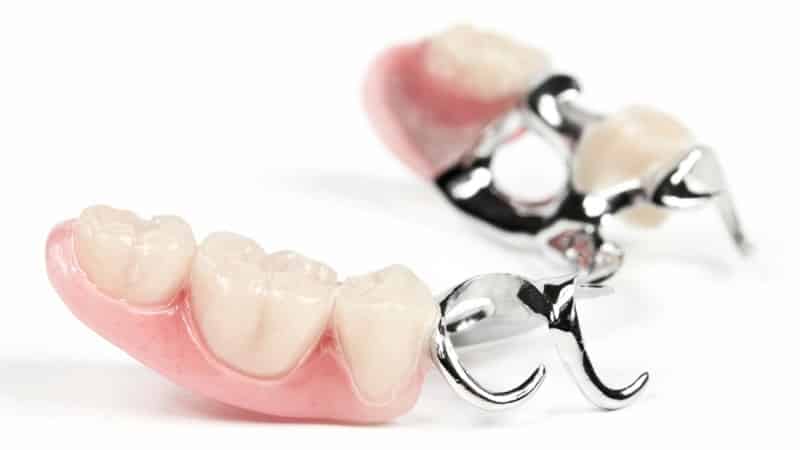
Removable dentures for back teeth
If a person does not have one tooth, mainly a molar, it is necessary to install ceramic or plastic devices. They are installed using special fasteners embedded in the crowns. Only a dentist can remove them.
Types of removable prosthetics:which ones are better?
To determine the type of prosthesis, it is worth taking into account the following aspects:
- the number of lost teeth;
- desired effect: non-removable devices resume the chewing function much better, but in order to maintain an attractive smile, it is worth using removable systems;
- practicality. Removable type structures need to be removed from time to time, because they are on the gums and create hard-to-reach places;
- material aspect. If the financial possibilities of a person are limited, it is worth stopping at cheaper versions: plastic products, etc.
How much do removable dentures cost and how to choose? This question the specialist who will find the most acceptable option for price and quality decides.
When choosing certain orthopedic products, contraindications should be taken into account. To date, dentists and orthopedists assure that there are no such contraindications that could not be eliminated. Due to the huge amount modern technologies in case of impossibility of application of one, it is possible to choose successfully another.
High-quality oral hygiene and timely seeking dental care will help keep your smile beautiful and healthy for a long time. But do without surgical intervention succeeds not always. Bad ecology, genetics, trauma - these are just a few reasons why you can lose your teeth even in young age. Prosthetics will help make your smile attractive. Which procedure option to choose? Let's try to figure it out.
Dental prosthetics. What it is?
Everyone knows that lost molars are not restored. Prosthetics is the main section of orthopedic dentistry. With this procedure, you can completely transform your smile. Even in old age a person will have all the teeth, although not native. Prosthetics is a partial or complete restoration of the structure and function of teeth. The aesthetic component here is not on last place. Many seek to put crowns in place of a darkened tooth. And with the help of veneers, you can successfully hide the hole between the central incisors.
Dental prosthetics in the absence a large number teeth are vital. Without crowns or implants, a person will not be able to chew food properly. As a result, there will be problems with gastrointestinal tract. And an ugly smile can cause many complexes. Neurosis and depression are provided. What type of prosthetics should be preferred? Consider different kinds procedures.
Removable prosthetics
Patient reviews show that this type of restoration of chewing function is the most common. Although the removable jaw in the glass causes negative emotions many, but this is one of the inexpensive ways to return beautiful smile. Most often, this type of prosthetics is used by older people who have almost completely lost their teeth.
 Today, new prosthetic technologies are emerging. To the great delight of patients, there are special creams on sale that can be used to securely fix prostheses. Thanks to this, everyone is able to easily chew any food. At the same time, you should not be afraid that the removable jaw will fall out in public.
Today, new prosthetic technologies are emerging. To the great delight of patients, there are special creams on sale that can be used to securely fix prostheses. Thanks to this, everyone is able to easily chew any food. At the same time, you should not be afraid that the removable jaw will fall out in public.
What are removable dentures?
There are dozens of different materials from which false teeth are made. Conditionally removable dentures are made on a plastic basis. Such a product is the most reliable and expensive. The manufacture of the prosthesis takes place in several stages. The dentist takes measurements. The manufacture of false teeth takes place in accordance with individual characteristics structure of the patient's skull.
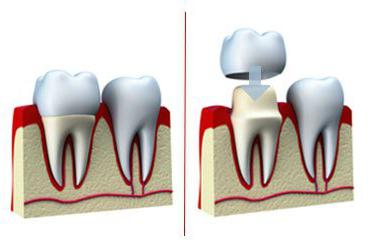 Prosthetics in the absence of a large number of teeth with removable plates is the most convenient from the point of view of dentistry. If an inflammatory process occurs in the oral cavity, the doctor can easily remove the plate and carry out treatment. The use of crowns in this regard is less convenient.
Prosthetics in the absence of a large number of teeth with removable plates is the most convenient from the point of view of dentistry. If an inflammatory process occurs in the oral cavity, the doctor can easily remove the plate and carry out treatment. The use of crowns in this regard is less convenient.
Removable small prostheses are also common today. They are mostly used with cosmetic purpose. With the help of such a product, you can mask damaged teeth or restore the integrity of a smile in the absence of several incisors. Each prosthesis is unique in its shape. The dentist takes careful measurements so that the dentures can fit perfectly in the oral cavity.
Fixed dental prosthetics
This is the most popular among middle-aged people. With the help of crowns, you can relatively inexpensively and quite effectively restore the dentition. The dentures look very natural. In rare cases, crowns can be distinguished from healthy teeth with the naked eye. Fixed dental prosthetics in the absence of a large number of teeth solves not only an aesthetic problem. It is also possible to restore the normal function of chewing. A person can easily consume solid foods.
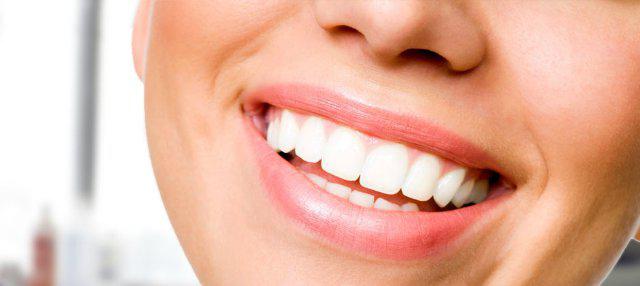 Today, there are a huge number of methods of fixed prosthetics. The indications for this procedure have also expanded. Gentle techniques allow you to restore the dentition even with inflammatory processes in the oral cavity. Dental crowns became available to the public. For a small fee, you can install prostheses that will last for a long time.
Today, there are a huge number of methods of fixed prosthetics. The indications for this procedure have also expanded. Gentle techniques allow you to restore the dentition even with inflammatory processes in the oral cavity. Dental crowns became available to the public. For a small fee, you can install prostheses that will last for a long time.
Clasp prosthetics
Popularity recent times acquires clasp prosthetics. What it is? Bugel is an arc. This means that the restoration of the dentition occurs with the help of an arc-shaped structure. This technique allows you to securely fix the prostheses. This is very important not only in the restoration of the dentition, but also in the treatment of periodontal disease. After all, with the help of byugels, you can not only fix crowns, but also fix a loose tooth. Any dentist will tell you that native incisors are much better at chewing. Therefore, first of all, you should try to save your teeth.
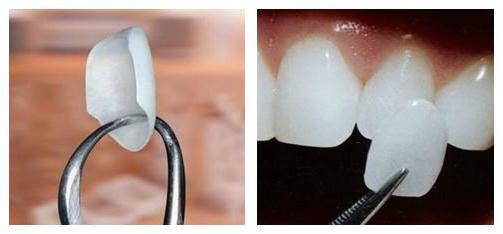 To date, clasp structures are being manufactured that differ high quality. In the oral cavity, they are installed in such a way that it is almost impossible for an outside observer to see them. This greatly enhances their aesthetic appeal. Clasp prosthetics in the absence of a large number of teeth is an excellent way out.
To date, clasp structures are being manufactured that differ high quality. In the oral cavity, they are installed in such a way that it is almost impossible for an outside observer to see them. This greatly enhances their aesthetic appeal. Clasp prosthetics in the absence of a large number of teeth is an excellent way out.
Metal-ceramic prostheses
The choice of material for dental prosthetics is a serious problem for many. After all, you want to get an attractive smile at a low cost. Metal-ceramic prostheses are popular among patients with an average level of income. They are distinguished by high reliability and relatively low price. Crowns made of this material can last more than 10 years. They look attractive and natural.
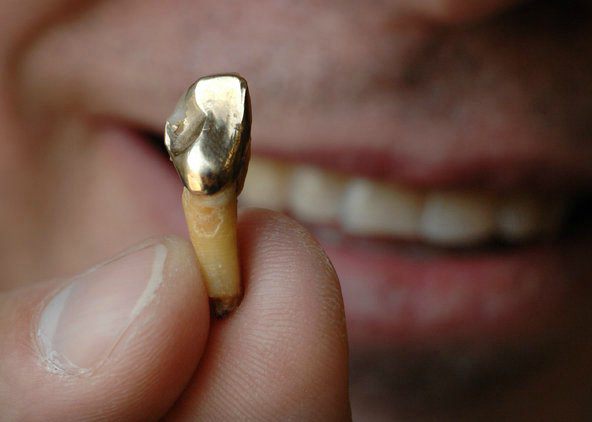 A significant disadvantage of metal-ceramic crowns is the need for extensive grinding of the tooth under the prosthesis. In some cases, it is necessary to depulp an absolutely healthy tooth. This is done to install inlays in order to increase the density of the incisor, on which the crown will subsequently be placed. Dental prosthetics in the absence of a large number of teeth with ceramic-metal crowns are often not performed. This technique is used if it is necessary to restore two damaged incisors located nearby.
A significant disadvantage of metal-ceramic crowns is the need for extensive grinding of the tooth under the prosthesis. In some cases, it is necessary to depulp an absolutely healthy tooth. This is done to install inlays in order to increase the density of the incisor, on which the crown will subsequently be placed. Dental prosthetics in the absence of a large number of teeth with ceramic-metal crowns are often not performed. This technique is used if it is necessary to restore two damaged incisors located nearby.
It should be borne in mind that the installation of metal-ceramic crowns requires a lot of patience on the part of the patient. The specialist will have to visit several times before the dentition is fully restored.
Microprosthetics
Restoring the structure of a tooth using internal inlays is called microprosthetics. This is one of the most promising areas in modern orthopedic dentistry. It is possible to restore the tooth and chewing function without the slightest loss. There is no need to go through a grinding procedure. Healthy incisors do not suffer at all. Very popular today is similar prosthetics in the absence of a large number of teeth. Reviews of doctors show that this technique is the most sparing and is closely related to therapeutic dentistry.
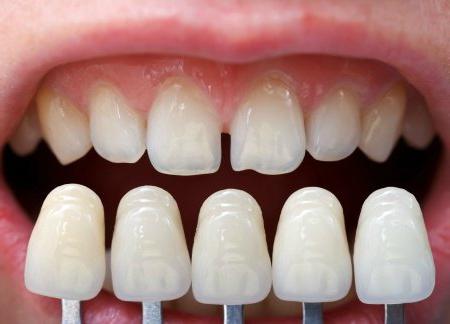 Microprosthetics allows you to restore only the structure of the tooth. In fact, this is no longer prosthetics, but the restoration of the dentition. The cost of services is often impressive. The procedure requires increased attention from the dentist. Materials are used only of high quality.
Microprosthetics allows you to restore only the structure of the tooth. In fact, this is no longer prosthetics, but the restoration of the dentition. The cost of services is often impressive. The procedure requires increased attention from the dentist. Materials are used only of high quality.
Bridges
Popular today is dental bridges in the absence of a large number of teeth. Photos of patients who have decided to use this service are impressive. With the naked eye, it is difficult to distinguish crowns from healthy teeth. The procedure involves the installation of a fixed orthopedic structure, which is attached with crowns. The bridge is most often made of cermet. This one is relatively inexpensive. Therefore, it is also popular with middle-income people.
The installation of bridges is not always possible. A prerequisite is the presence of healthy teeth to the right and left of the structure. This is necessary in order to be able to securely fix the bridge. Abutment teeth are pre-grinded. In the future, crowns are installed on them. In rare cases, the dentist has to perform the depulpation procedure.
Bridges are made in the laboratory. The dentist takes preliminary measurements. Prosthetics of teeth (metal-ceramics) takes place in several stages. Patient reviews show that the installation of bridges brings some inconvenience. For several days, the chewing function is absent. From an aesthetic point of view, the oral cavity also looks unattractive. But after the installation of the bridge, the crowns are difficult to distinguish from healthy teeth.
Installation of implants
This type of prosthetics refers to conditionally removable. Root screws are installed on the patient, on which implants are put on. This method of prosthetics is one of the most expensive. For artificial teeth, the most quality materials. If it is necessary to perform a restoration, the implant can be easily unscrewed.
Installing screws in the oral cavity is a very painful procedure. In most cases, the operation is performed under general anesthesia. Few are licensed to provide such services. dental clinics. This is one of the reasons for the high cost of conditionally removable prosthetics using implants.
Dental veneers
Installing veneers today is great alternative crowns and prostheses. The problem is that veneers can only be attached to the front teeth. These are special ceramic or composite plates that are attached to the surface of the front teeth with the help of a special solution. Such designs can only be used on frontal incisors. For chewing teeth, standard crowns are suitable.
Veneers allow you to restore the dentition as quickly as possible. Linings are attached even to those teeth that are destroyed almost to the gums. In just one day, the patient can get an attractive smile. It is almost impossible to distinguish veneers from natural teeth. Such dentures are relatively inexpensive. How to choose the material for veneers, the doctor will tell you. Ceramic plates are considered the most durable.
Article navigation
The absence of two or more adjacent teeth is one of the most common cases in dentistry. Restoring the aesthetics and functionality of the dentition involves several solutions: you can use a removable denture or install a dental bridge based on two or more adjacent living teeth. However, most dentists agree that the most in an efficient way is dental implantation.
Classic options for prosthetics: why not?
In the absence of two or more teeth nearby, the most common method of closing a gap in a row is considered to be the installation of a dental bridge - this is an alternative to dental implantation. In place of the missing teeth there will be "suspended" (middle of the bridge), and along the edges of the bridge there will be crowns resting on the abutment teeth. The more missing teeth, the more abutment teeth are used.
Abutment teeth are subject to depulpation and turning for the installation of a bridge, and this is one of the main disadvantages of dental bridges.
If the living teeth are in bad condition and will not withstand the load from the prosthesis, the patient has one more option - to close the gap between the teeth with removable dentures.
It should also be remembered that in both cases, under the prostheses, the process of bone atrophy actively continues, which occurs when there is no load on it. Gradually, a small gap appears between the prosthesis and the edge of the gum due to a decrease in bone volume.
Multi-tooth implant options
In the absence of two teeth, an individual implant is installed under each of them, and a dental bridge from the selected material is fixed on top. If more than three teeth are missing in a row, then the number of implants is selected individually, you can install 2 implants and a dental bridge of 3 crowns. However, at the request of the patient, it is also possible to restore each tooth separately with the help of an implant and a single crown. Most often, for the restoration of several teeth in the frontal zone, patients are recommended dental implantation according to the classical protocol, which allows to obtain a predictable result and good aesthetics of the gingival contour. The only drawback of this approach is its delayed loading, a permanent prosthesis can be placed only after the implants are completely engrafted, while a temporary prosthesis-butterfly will have to be worn for the duration of the fusion of the implants with the bone.
For those who do not want to wait, this process can be shortened by immediate loading implantation, which allows the patient to receive new teeth in minimum terms(usually no more than 5 days). However, implantation with immediate loading has an important limitation, its goal is primarily to restore the functionality of the dentition and for some clinical cases the aesthetic aspect will be unsatisfactory. To understand whether this method is suitable, you need an examination by an implantologist.
Advantages of implantation in multiple restorations
- preservation of neighboring teeth: there is no need for preparation (turning) and depulpation of neighboring living teeth, on which a bridge is put on;
- high aesthetics: artificial teeth based on implants are almost impossible to distinguish from natural ones;
- preservation of bone tissue: chewing load is transferred to the bone through the implant, so it “works” in the usual mode and does not decrease in size,
- reliability and durability of implants: implants are made of the strongest titanium, which allows them to withstand high chewing loads and serve for 20-30 years. For prosthetics on implants, it is also better to choose strong, durable structures, such as metal ceramics or zirconium dioxide. If over time it becomes necessary to replace the prosthesis, it is carefully removed and replaced with a new one, while the implants remain in the bone tissue.
Thus, dental implantation is the most effective and aesthetic way to restore two or more lost, previously adjacent teeth.
The cost of implantation of several teeth:
When restoring several teeth in a row, the cost of dental implantation may vary depending on whether each tooth will be restored with a separate implant and crown, or a dental bridge will be installed. For example, in the absence of three teeth, you can install three implants and three crowns, or a bridge of three crowns supported by two implants, thus saving on quantity. The second important factor affecting the cost of dental implantation is the type of dental crowns, since the difference in price between various materials may be significant. However, when choosing the method of implantation and the type of crowns, one should not be guided solely by considerations of economy, since the quality of the materials primarily affects the service life of new artificial teeth.
You can learn more about the cost of all manipulations at a free consultation with an implantologist, since only after examining the oral cavity and diagnosing it will be possible to draw up specific treatment plans, choose best options restoration of teeth for each individual case. However, do not forget that in clinics hotline special promotions for dental implantation are regularly held, which will allow you to receive high-quality treatment at a bargain price.
Article navigation
An end defect is usually called the absence of one or more of the most recent teeth in a row. This is one of the most difficult and unpleasant problems for the patient because main function lateral teeth - chewing products. Their absence leads to the fact that we cease to fully eat. Moreover, it also changes appearance: wrinkles appear on the face, cheeks sag and literally tumble into the mouth, not to mention bite changes.
Causes and consequences of the absence of chewing teeth
According to statistics, most often patients turn to the problem of the absence of chewing teeth, since the main share of the chewing load falls on them. Therefore, they are destroyed, as a rule, faster than the front teeth. Poor oral hygiene, bad habits, eating acidic foods and many other factors accelerate the process of tooth decay. Here are some popular causes of loss of posterior teeth:- Caries: first, caries destroys the surface protective layer of the teeth - enamel, after which it penetrates into the deeper layers of the tooth, turning into pulpitis or periodontitis. In case of untimely treatment, the tooth can be destroyed so badly that it cannot be restored. It will be necessary to remove along with the root to prevent further complications;
- Inflammatory diseases gums, leading to resorption of the bone tissue around the roots of the teeth (even if the teeth themselves are healthy) and the ligaments that hold the tooth in the hole. Teeth begin to loosen and inevitably fall out over time. Unfortunately, few people think about the consequences of diseases such as periodontitis and periodontal disease until it is too late and treatment is no longer possible;
- Cysts of the roots of the teeth: inflammatory formations on the roots of the teeth large sizes are also an indication for root extraction in order to avoid much more severe consequences. About cysts small size the patient may not even know, since they do not manifest themselves. They are detected only by the dentist when examining the picture. Therefore, the only thing that a patient can do to avoid the growth of cysts is to undergo regular preventive examinations.
If the patient is still faced with the problem of destruction or loss of chewing teeth, then urgent prosthetics is simply necessary. And it's not just about aesthetics. The absence of even one chewing tooth already significantly complicates the normal chewing of food, the teeth begin to shift, the bite changes, the shape of the face changes. Occlusion misalignment also leads to more and more problems over time. Therefore, it is easier and cheaper, and most importantly, it is more useful for the patient to contact the dentist as soon as possible to restore the teeth.
Methods for restoring chewing teeth
The absence of the most distant teeth in the row, both on the upper and on mandible- this is serious problem, which is not easy to solve. Indeed, to install bridges, two supports are required - on both sides. And in the case of an end defect, the teeth are preserved only on one side, that is, there is only one support for the prosthesis (and then, if the condition of the living teeth allows you to fix artificial teeth on them). Therefore, patients may have only a few options for solving the problem:
- removable prosthetics: the prosthesis can be made of acrylic, soft plastics (nylon, acry fries, quadrotti), it can be fixed on one side on the remaining teeth, and on the other side only on the gums, they will literally stick or stick to them, it can also be a clasp prosthesis was made;
- dental implants: two-stage and one-stage. it best method to solve the problem of an end defect that does not affect adjacent teeth.
Benefits of implantation
- full restoration of chewing function: the tooth is restored together with the root using high-strength materials, which allows you to restore normal chewing function;
- prevents bone atrophy: unlike removable dentures, implants stimulate natural processes exchange in bone cells, so the bone will not sag, and the bite will remain correct;
- comfort for the patient: new teeth on implants feel natural, unlike removable dentures, they are motionless in the oral cavity, do not have artificial gums, do not injure the mucous membrane, and also do not cause changes in diction;
- great aesthetics: dental crowns on implants are almost indistinguishable from natural teeth;
- long term services: Dental implants can last for decades, permanent crowns on them for 15-20 years, depending on the material. In order to maximize the life of dental crowns on implants, it is necessary to follow the rules of hygiene and handle crowns with care;
- only missing teeth are restored, while neighboring healthy teeth are not injured, as opposed to bridge or removable prosthetics.
Stages and methods of implantation of chewing teeth:
The first stage is a visit to the dentist, he examines the oral cavity and analyzes the images to assess the condition of the bone tissue and identify if there are any problems in the oral cavity that prevent implantation. The implantologist also asks the patient about his state of health in order to identify the presence of possible contraindications. Based on the results of the visit, a treatment plan is drawn up, an implant system, installation method and type of dental crowns on implants are selected;At the preparation stage, it is necessary to exclude all relative contraindications, and also to make hygienic cleaning teeth to avoid rejection due to the presence of pathogenic microbes in the oral cavity. After successful preparation, you can proceed to the direct implantation of the teeth, depending on the chosen method.
Prosthetics is the restoration of lost molars in adults and children with the help of artificial prostheses. This process solves several problems:
- resumption of chewing function;
- prevention of the development of any complications and serious diseases;
- improving the quality of life;
- elimination negative consequences for the psyche due to the lack of anterior crowns.
When is dentures needed?
Prosthetics are indicated if certain prerequisites are present. On the simple example(loss of one or more teeth) it will become clear why this is so:
The main indications for the insertion of artificial teeth:
- Significant destruction of the crown (resuscitation by filling is impossible). As a rule, in this case, it is worth replacing one missing organ with inlays or artificial crowns.
- The crown was removed entirely. Pin insertion shown.
- Erasure of the upper and lower teeth in a pathological form. Prosthetics with veneers or crowns.
- Adentia (there are no teeth themselves and their roots). The method of prosthetics directly depends on the characteristics of the defect.
- Numerous pathologies of the dentition. With age, there are many problems that are an indication for the insertion of prostheses. All methods of restoration of molars and prostheses of any design are used - the decision to put a gold, ceramic or other tooth is made by the patient together with an orthopedic dentist.
Options for replacing natural teeth - before and after photos

The choice of type of prosthetics is directly dependent on specific situation and material wealth of the patient (both gold and ceramic teeth are made). You can and should make a decision together with the dentist. There is no need to rely on the positive reviews of relatives and friends, if they were satisfied with one or another type of false prosthesis, because each organism is individual.
Which tooth to insert is decided by the patient, taking into account the opinion of the attending physician. The best solution- rely on the patient's state of health, his lifestyle before the procedure and financial capabilities, instead of the opinions of strangers.
Removable or not?
Fixed dentures are more expensive than removable ones, which is explained by their strength and good biological compatibility of manufacturing materials with dental and gum tissues (the article presents photos before and after fixed prosthetics). Installation technology will depend on each specific case. The types of such prosthetics include the following:
- inlays and veneers (reanimate damaged teeth and restore their former appearance);
- crowns (imitate the natural shape of the extracted tooth);
- bridges (a combination of several crowns in one design);
- implants (artificial roots intended for the subsequent installation of artificial crowns on them).
Mounting methods
Dental prostheses are attached using their own elements or using additional funds commits:
- Clasps (hooks). A type of attachment that is cheap. It is used for removable prosthetics, it is made from materials for the manufacture of the base of the prosthesis (metal, acrylic, polyurethane, nylon, etc.). Clasps are located at the base of the abutment teeth.
- Attachments (also called locks). They are used for removable and non-removable bridge prosthetics. They have an important advantage over clasps: they can be overlooked by others, since they are fixed in the recess of the supporting teeth and are closed from above with crowns.
- Flexible base. Expensive prosthetics. Production material: nylon or polyurethane (cheaper domestic analogue). They are attached using a flexible base made of natural substances that are securely adhered to the oral mucosa without the use of additional agents.
- Dental adhesive ("cement"). Crowns, veneers and inlays are fixed on it.
- Additional means of fixation. These are gels and creams, presented in a wide range in all pharmacies. Allow to fix removable or conditionally removable prostheses.
Microprosthetics of the anterior teeth
Microprosthetics is a modern dental procedure. Its goal is to preserve the dentition with significant destruction, improve the aesthetic component of the teeth and restore chewing function. There are the following types:
- Adhesive. Allows replacement of one or more missing front teeth. In most cases, high-strength fiberglass is used, so the structures of this type may even serve long years. This method necessary for those people who are at risk of allergies to metal (with the exception of gold teeth) prostheses or their bases. The cost of a fiberglass prosthesis is lower than with other materials.
- Installation of veneers (overlays). Veneers are thin plates that are attached to the outer part of the tooth and significantly improve its appearance (shape, color). They hide chips and areas of blackening on the enamel. Also, the pads allow you to hide the gaps between the front teeth and protect the enamel from exposure. external factors(coffee plaque, tobacco smoke, mechanical damage).
- Tab prosthetics. This is the use of special laboratory-made fillings, which have not only increased strength, but also a beautiful appearance.
- The use of pins. Apply in the case when the crown is destroyed, but the root is healthy. The pin is placed in the root of the tooth, and an artificial crown is placed on top. You can insert a tooth without turning the adjacent chewing organs.
Material selection
Even in ancient times, people tried to find a replacement for lost teeth, using wood, stones, pearls, gold and other items. In modern dentistry, everything is different - prostheses are durable and safe for the patient's health. The most common manufacturing materials:
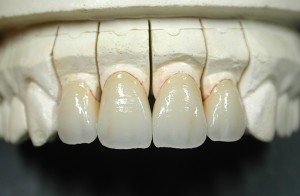
In each specific situation, materials are selected individually. It all depends on the indications for prosthetics, its method, the wishes of the patient and financial capabilities.
plastic
Plastic dentures are made from acrylic. They are used in the complete or partial absence of teeth. Varieties:
- Lithium and pressed. The former are attached to the jaw with high precision, almost indistinguishable from "living" teeth. The second ones are easier to manufacture, but inferior to lithium ones in quality.
- Removable (used most often) and non-removable.
- Permanent and temporary.
Ceramic
Ceramics is a material intended for the manufacture of durable and aesthetically attractive dental crowns. There are several options for the execution of ceramic prostheses:
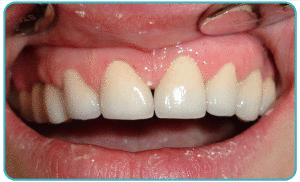
Advantages and disadvantages of different types of prostheses
Advantages of plastic dentures:
- can be used as temporary;
- have a low cost;
- there is a resemblance to natural teeth.
Flaws:
- wear out quickly;
- irritate the oral mucosa;
- sometimes cause allergies;
- some time after installation, food debris may accumulate under the crown;
- cause discomfort.
Advantages of ceramic prostheses:
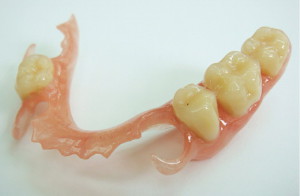
Flaws:
- there is a possibility of chips after prolonged use;
- high price.
Overview of the cost of dentures - which are the most expensive?
When it becomes necessary to insert a denture, the patient is always interested in how much money he will have to pay for it. Most often, the choice of one or another method of prosthetics depends on financial capabilities. The price is affected by:
- material of manufacture (gold teeth will be better, but they are more expensive than acrylic ones);
- design features (clasp, lamellar, bridge-like, etc.);
- the complexity of the installation (the number of lost teeth, the need for preliminary treatment and restoration).
The cheapest dentures are made of acrylic, which cannot be said about other materials. Clasp and nylon are about 3 times more expensive. The price of bridges will depend on the design and material of the crowns.
Gold artificial teeth have been inserted since ancient times. More recently, at the end of the 20th century, gold crowns were very popular and were a sign of the wealth of their owner. AT last years patients are increasingly asking for gold prostheses with a special coating that mimics natural fabric. Gold alloy teeth do not cause allergic reactions.














